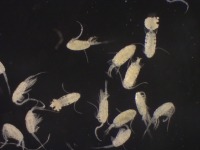
(Photo: Huntsman Marine Science Centre)
Herdman's Eurytemora
Eurytemora herdmani
Microscopic copepod, oblong body shape with long antennae and a short urosome (tail). Large wing-like ends to the prosome (body) look like a skirt. Females are 1.5 to 2.6 millimetres in length and males are 1.2 to 1.5 millimetres in length.
Authority
Scott and Herdman, 1897
Classification Details
Phylum: Arthropoda (arthropods); Subphylum: Crustacea (crustaceans); Subclass: Copepoda (copepods).
Habitat
Planktonic, found in the water column from the Arctic to Cape Cod. Although it may be found in fully saline seawater it prefers lower salinities such as glacial waters and estuaries. The temperature and the salinity of the water both impact population levels.
Diet
Grazer. Feeds on diatoms and cyanobacteria.
Reproduction
Separate sexes. Males and females attract each other using pheromones that circulate in the water. Males attach a spermatophore, in which sperm reside, to the female's urosome to fertilize the eggs. The females carry the fertilized eggs in an egg sac until the time that they hatch. Like other copepods, hatched eggs go through several nauplii and copepodite stages before becoming adults. Adults live 40 to 100 days.
Fun Facts
The presence of predators reduces mating frequency. When there is a high proportion of males, mating success reduces due to competition between males.
Eurytemora are an important food for many fish such as white perch, herring, and bass.
References
George VS (1985) Demographic evaluation of the influence of temperature and salinity on the copepod Eurytemora herdmani. Marine Ecology Progress Series 21, 145–152. Johnson WS & Allen DM (2005) Zooplankton of the Atlantic and Gulf Coasts. Maryland: Johns Hopkins University Press. Lasley-Rasher RS, Kramer AM, Burdett–Coutts V, Yen J (2014) Assessing the In Situ Fertilization Status of Two Marine Copepod Species, Temora longicornis and Eurytemora herdmani; How Common Are Unfertilized Eggs in Nature? PLoS ONE 9(11), e112920. Lasley–Rasher RS and Yen J (2012) Predation risk suppresses mating success and offspring production in the coastal marine copepod, Eurytemora herdmani. Limnology and Oceanography 57, 433–440. Teegarden GJ (1999) Copepod grazing selection and particle discrimination on the basis of PSP toxin content. Marine Ecology Progress Series. 181, 163–176. Van Guelpen L, Pohle G, Vanden Berghe E and Costello MJ (2005) Marine Species Registers for the North Atlantic Ocean. World Wide Web electronic publication. http://www.vliz.be/vmdcdata/narms/ Walter TC and Boxshall G (2020) World of Copepods database. Eurytemora herdmani Thompson I.C. & Scott A., 1897 in Thompson, Scott & Herdman, 1897. Accessed through: World Register of Marine Species at: http://www.marinespecies.org/aphia.php?p=taxdetails&id=157670 Accessed online 20 January 2020.

